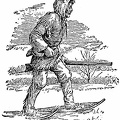113/152
Mountain Sheep.—It is evident from the form of the unbranched horns, the slender legs, and the head, that either a mountain sheep or mountain goat was intended to be represented. The markings on the body are symbolic, suggesting lightning, and it may be added that the Hopi depict the lightning on the artificial horns mounted on caps and worn by them in presentations of dances in which they personate mountain sheep.
- Auteur
- Archeology of the lower Mimbres valley, New Mexico
By Jesse Walter Fewkes
Published in 1914
Available from gutenberg.org - Ajoutée le
- Dimanche 23 Avril 2023
- Dimensions
- 1200*1190
- Mots-clés
- Art, Historic Artefact, mammals, Place:New Mexico, Prehistoric
- Albums
- Visites
- 1959
- Téléchargements
- 58
 Télécharger la photo
Télécharger la photo





